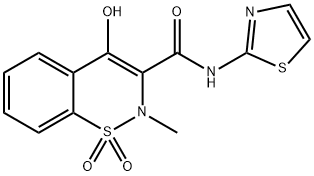34042-85-8
 34042-85-8 結構式
34042-85-8 結構式
基本信息
舒多昔康,10 MM DMSO 溶液
4-Hydroxy-2-methyl-3-(2-thiazolylcarbamoyl)-2H-1,2-benzothiazine 1,1-dioxide
4-Hydroxy-2-methyl-N-(thiazol-2-yl)-2H-1,2-benzothiazine-3-carboxamide 1,1-dioxide
2H-1,2-Benzothiazine-3-carboxamide, 4-hydroxy-2-methyl-N-2-thiazolyl-, 1,1-dioxide
4-hydroxy-2-methyl-1,1-dioxo-N-(1,3-thiazol-2-yl)-1$l^{6},2-benzothiazine-3-carboxamide
物理化學性質
常見問題列表
COX
Sudoxicam demonstrates NADPH-dependent covalent binding to human liver microsomes. With addition of glutathione (GSH) in microsomal incubations, about half of the covalent incorporation of Sudoxicam is blocked by addition of GSH.
Metabolite identification studies on [14C]-Sudoxicam in NADPH-supplemented human liver microsomes indicated that the primary route of metabolism involved a P450-mediated thiazole ring scission to the corresponding acylthiourea metabolite (S3), a well-established pro-toxin.
In vitro, Sudoxicam underwent the oxidative thiazole-open biotransformation, resulting in the formation of an acylthiourea and the subsequent hydroxylated metabolite.
Sudoxicam (1-10 mg/kg; oral administration; daily; for 7 days; rats) treatment effective reduces plasma inflammation units, reduces the swelling of inflamed hind-paws and restores toward normal the daily gain in body weight.
In the intact rat, Sudoxicam significantly inhibited edema formation at doses as low as 0.1 mg/kg, p.o.
Sudoxicam inhibits the erythema caused by ultraviolet irradiation in the guinea pig.
Sudoxicam (3.3 mg/kg, i.p.) is capable of counteracting the pyrexia induced by the intraperitoneal injection of typhoid/paratyphoid vaccine in rats, maintaining body temperature about that of uninjected control rats.
The plasma half-life of Sudoxicam ranged between 8 hours (monkey), 13 hours (rat), and 60 hours (dog).
| Animal Model: | Rats injected with ,i>M. butyrieum |
| Dosage: | 1 mg/kg, 3.3 mg/kg, 10 mg/kg |
| Administration: | Oral administration; daily; for 7 days |
| Result: | Were both effective in reducing plasma inflammation units, in reducing the swelling of inflamed hind-paws. |